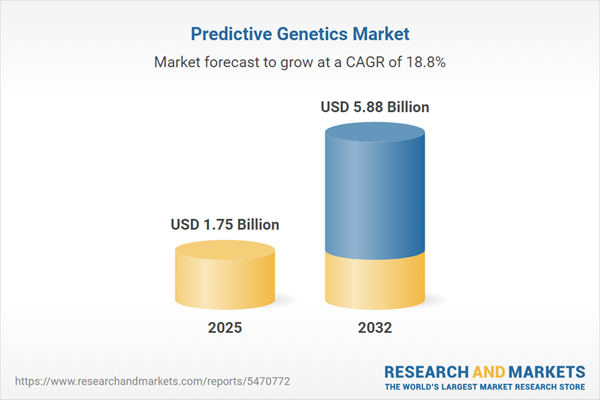Speak directly to the analyst to clarify any post sales queries you may have.
Predictive genetics is transforming healthcare leadership by providing actionable insights that support personalized, data-driven care delivery. As advances in genomics and analytics continue to evolve, organizations are reevaluating their competitive strategies, technology investments, and partnership approaches to stay ahead in this dynamic field.
Market Snapshot: Predictive Genetics Market Size and Growth
The predictive genetics market reached a value of USD 1.47 billion in 2024 and is forecast to grow to USD 1.75 billion by 2025, underscoring rapid adoption across healthcare environments. This growth signals a paradigm shift as genomics, bioinformatics, and advanced analytics shape new opportunities in clinical diagnostics and population health. Personalized medicine continues to drive demand, with stakeholders seeking standardized care, operational efficiency, and stronger patient-oriented service models to ensure market resilience and differentiation.
Scope & Segmentation: Predictive Genetics Application Areas
This report delivers actionable market intelligence for senior decision-makers evaluating strategic moves within the predictive genetics domain. Segmentation insights below highlight key areas for technology adoption, partnership alignment, and value creation throughout the industry ecosystem:
- Technology Platforms: Microarray systems, Next Generation Sequencing for high-throughput sequencing, Polymerase Chain Reaction for sensitive genetic mutation detection, and Sanger Sequencing for confirmatory analyses all provide capabilities tailored to specific diagnostic needs.
- Test Types: Cancer risk assessments enable preventative care strategies; carrier screening informs reproductive decision-making; pharmacogenomics tailors medication choices; prenatal genetic tests identify early indications of inherited risk; hereditary disorder diagnostics enable precise interventions.
- Application Areas: Key areas include cardiovascular disease management, infectious disease tracking, rare and neurological disease identification, and precision oncology, providing a foundation for evidence-driven clinical workflows.
- End Users: Academic research institutions, clinical laboratories, hospitals with genomics integration, and direct-to-consumer genetic service providers are primary market drivers.
- Product Types: Laboratory consumables, specialty analytical instruments, sequencing and analytics services, clinical counseling resources, and decision-support software contribute across workflows for operational accuracy.
- Regions: Major regions are North America, Latin America (including Brazil, Argentina, Chile), Europe, Middle East, Africa, and Asia-Pacific, each demanding specialized regulatory and deployment strategies to maximize reach and compliance.
- Key Companies: Leading enterprises such as Myriad Genetics, Invitae, Natera, 23andMe, Fulgent Genetics, Guardant Health, Color Health, Helix OpCo, Gene by Gene, and Genomic Prediction play a crucial role in advancing adoption and shaping ecosystem standards.
Key Takeaways for Healthcare Executives
- Genomics-powered analytics support earlier disease risk identification, allowing for improved care pathway design and optimized resource distribution.
- Advanced sequencing technologies and digital pathology infrastructure enhance data consistency and ensure transparent clinical results across networks.
- Cross-sector collaboration involving care providers, research organizations, pharmaceutical firms, and regulators encourages speedier solution adoption and continuous pipeline innovation.
- Investing in modular, scalable infrastructure enables organizations to adapt quickly to shifts in clinical and regulatory requirements, strengthening agility and operational efficiency.
- Proactive strategic planning that reflects regulatory trends and regional healthcare needs safeguards both stakeholder and patient interests for the long term.
Tariff Impact on Global Supply Chains
Tariff regulations in the United States are prompting industry leaders to diversify supplier portfolios and invest in domestic production capabilities, reducing risk from global disruptions. Enhanced collaboration with public sector entities is also enabling more resilient supply continuity and supporting innovation within the predictive genetics landscape.
Methodology & Data Sources
This report is based on insights gathered from expert interviews, in-depth analysis of patent and regulatory data, and systematic reviews of leading scientific literature. These diverse sources provide robust, actionable intelligence for executive decision-makers engaged in predictive genetics strategy.
Why This Predictive Genetics Market Report Matters
- Comprehensive segmentation and current technology analysis inform precise investment targeting and smart market positioning for healthcare organizations.
- Guidance is provided for compliance and commercial teams to strengthen supply chain resilience amid regulatory complexity.
- The report benchmarks adoption patterns, helping executives forge effective partnerships and refine market entry strategies in a competitive healthcare sector.
Conclusion
Continual adaptation to regulation and innovation is critical to achieving precise, value-focused healthcare outcomes. This report equips organizational leaders to remain agile, competitive, and prepared for ongoing developments in predictive genetics.
Additional Product Information:
- Purchase of this report includes 1 year online access with quarterly updates.
- This report can be updated on request. Please contact our Customer Experience team using the Ask a Question widget on our website.
Table of Contents
3. Executive Summary
4. Market Overview
7. Cumulative Impact of Artificial Intelligence 2025
Companies Mentioned
The companies profiled in this Predictive Genetics market report include:- Myriad Genetics, Inc.
- Invitae Corporation
- Natera, Inc.
- 23andMe Holding Co.
- Fulgent Genetics, Inc.
- Guardant Health, Inc.
- Color Health, Inc.
- Helix OpCo, Inc.
- Gene by Gene, Ltd.
- Genomic Prediction, Inc.
Table Information
| Report Attribute | Details |
|---|---|
| No. of Pages | 180 |
| Published | October 2025 |
| Forecast Period | 2025 - 2032 |
| Estimated Market Value ( USD | $ 1.75 Billion |
| Forecasted Market Value ( USD | $ 5.88 Billion |
| Compound Annual Growth Rate | 18.8% |
| Regions Covered | Global |
| No. of Companies Mentioned | 11 |









